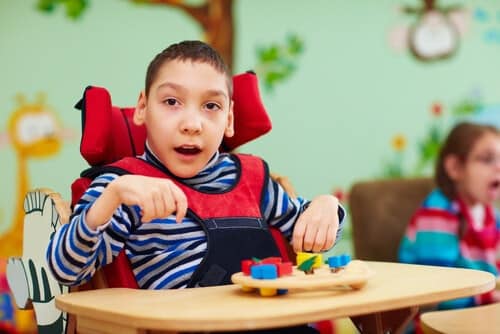Cerebral Palsy Damages Claims
Last updated Friday, November 29th, 2024

The deprivation of oxygen during birth exposes a fetus to the serious risk of various forms of hypoxic ischemic encephalopathy. In many cases, the causes of this serious condition can be traced to mistakes on the part of the obstetrician, the anesthesiologist or a nurse.
If you suspect that the especially severe consequence of cerebral palsy in your delivery could have resulted from negligence on the part of your obstetric team, you might be entitled to financial compensation through a birth injury lawsuit. Contact the AV Preeminent* litigation firm of Wocl Leydon, LLC to learn about your rights and legal options.

Get Your FREE Case Review,
In Person or Virtually Online
Experienced Trial Lawyers for All Forms of Cerebral Palsy Birth Injuries
Our attorneys work with medical experts to investigate the causes of a serious fetal brain injury in your family. Our goal is to identify just what went wrong and caused any of the following types of cerebral palsy:
- Spastic cerebral palsy: This is the most common form of cerebral palsy, accounting for roughly 70 to 80 percent of all diagnoses. This type of cerebral palsy keeps the muscles in a constant state of increased involuntary reflex.
- Athetoid cerebral palsy: Approximately 10 to 20 percent of cerebral palsy patients are diagnosed with this form of the condition, which is characterized by a slow and uncontrolled movement.
- Ataxic cerebral palsy: This rare form occurs in 5 to 10 percent of cerebral palsy cases and is characterized by balance and depth perception problems that can cause difficulty with walking, controlling limbs and performing daily tasks.
- Mixed cerebral palsy: This form of cerebral palsy is a combination of spasticity (stiff muscles) and athetoid (uncontrolled) movements.
In some cases, it is immediately apparent that an infant has suffered some type of birth-related brain injury such as cerebral palsy. In other cases, however, problems and conditions are often not diagnosed until a child has failed to reach certain milestones as expected during the first years of development.
Examples of Medical Negligence as Causes of Cerebral Palsy
Medical negligence can account for the failure of a doctor or a nurse to identify the risk factors that can produce hypoxic or ischemic conditions, or decreased oxygen levels or blood flow to the brain. When these conditions occur during delivery, the infant is exposed to a high risk of birth with one of the four types of cerebral palsy described above. Examples of common medical errors include:
- Failure to monitor the fetal heart rate during labor
- Failing to monitor the mother or the infant before, during or after childbirth
- Failing to take prompt action in response to signs of fetal distress
- Leaving a mother unattended during labor
- Giving a mother the wrong type or wrong dose of anesthesia
- Administering an anesthetic incorrectly
- Failing to perform a C-section procedure in timely fashion
- Misdiagnosing or mistreating of postpartum complications such as jaundice (hyperbilirubinemia)
- Failing to intubate the newborn after delivery

Get Your FREE Case Review,
In Person or Virtually Online
Bridgeport Birth Injury Lawyers ∙ Stamford Cerebral Palsy Attorneys
No one knows exactly how many of the more than 3,000 new cases of cerebral palsy diagnosed among U.S. children each year are the result of medical mistakes or errors made during the labor and delivery process. At Wocl Leydon, LLC, in Stamford and Bridgeport, Connecticut, our many years of experience in birth injury litigation have given our lawyers a solid understanding of the ways these errors can happen. We also know that they are much more common than the medical community would lead you to believe.
To gain a better understanding of your rights and legal options regarding cerebral palsy related to medical negligence, contact our attorneys at either of our Fairfield County locations for a free consultation.
We represent clients statewide and handle all of our medical malpractice cases on a contingency basis. There are no legal fees to pay unless we win.
*AV Preeminent and BV Distinguished are registered certification marks of Reed Elsevier Properties Inc., used in accordance with the Martindale-Hubbell certification procedures, standards, and policies. Martindale-Hubbell is the facilitator of a peer review rating process. Ratings reflect the confidential opinions of members of the Bar and the judiciary. Martindale-Hubbell ratings fall into two categories – legal ability and general ethical standards.

